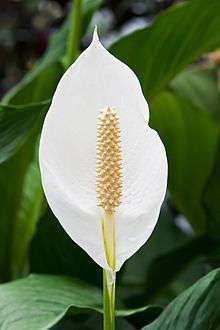Pseudanthium

A pseudanthium (Greek for "false flower") or flower head is a special type of inflorescence,[1] in which anything from a small cluster to hundreds or sometimes thousands of flowers are grouped together to form a single flower-like structure. Pseudanthia take various forms. The individual flowers of a pseudanthium commonly are called florets.[2] The real flowers (the florets) are generally small and often greatly reduced, but the pseudanthium itself can sometimes be quite large (as in the heads of some varieties of sunflower).
Pseudanthia are characteristic of the daisy and sunflower family (Asteraceae), whose flowers are differentiated into ray flowers and disk flowers, unique to this family. The disk flowers in the center of the pseudanthium are actinomorphic and the corolla is fused into a tube. Flowers on the periphery are zygomorphic and the corolla has one large lobe (the so-called "petals" of a daisy are individual ray flowers, for example). Either ray or disk flowers may be absent in some plants: Senecio vulgaris lacks ray flowers[3] and Taraxacum officinale lacks disk flowers.[3][4] The pseudanthium has a whorl of bracts below the flowers, forming an involucre.
In all cases, a pseudanthium (inflorescence) is superficially indistinguishable from a flower, but closer inspection of its anatomy will reveal that it is composed of multiple flowers. Thus, the pseudanthium represents an evolutionary convergence of the inflorescence to a reduced reproductive unit that may function in pollination like a single flower, at least in plants that are animal pollinated.
Related terms
Head
This is an equivalent term for flower head and pseudanthium when used in the botanical sense.[5][6]
Capitulum (plural capitula)
Capitulum can be used as an exact synonym for pseudanthium and flower head;[2][7][8] however its use is generally but not always restricted to the Asteraceae family. At least one source defines it as a small flower head.[9] In addition to its botanical use as a term meaning flower head it is also used to mean the top of the sphagnum plant.[10]
Calathid (plural calathids or calathidia)
This is a very rarely used term. It was defined in the 1966 book, The genera of flowering plants (Angiospermae), as a specific term for a flower head of a plant in the Asteraceae family.[1] However, on-line botanical glossaries do not define it and Google Scholar does not link to any significant usage of the term in a botanical sense.
Plant families

Pseudanthia occur in the following plant families:
- Apiaceae — pseudanthia are called umbels
- Araceae — pseudanthia are called spadices
- Asteraceae
- Campanulaceae
- Centrolepidaceae
- Cornaceae
- Cyperaceae
- Dipsacaceae
- Euphorbiaceae — pseudanthia are called cyathia
- Eriocaulaceae
- Hamamelidaceae
- Moraceae
- Poaceae
- Pontederiaceae — in Hydrothrix
- Proteaceae
- Rubiaceae
- Saururaceae — in Anemopsis
In some families it is not yet clear whether the 'flower' represents a pseudanthium, because the anatomical work has not been done (or is still ambiguous due to considerable evolutionary reduction). Possible pseudanthia of this type may occur in the following families:
Gallery
 Diagram of a flower head. Note bracts surrounding the flowers, which would be absent on a capitulum.
Diagram of a flower head. Note bracts surrounding the flowers, which would be absent on a capitulum..jpg) Flower head of a common daisy (Bellis perennis)
Flower head of a common daisy (Bellis perennis) Flowers open in succession in head of a sunflower (Helianthus annuus), with ray florets forming the 'petals'
Flowers open in succession in head of a sunflower (Helianthus annuus), with ray florets forming the 'petals' Close up of the ray corolla of a Hieracium lachenalii; every "petal" is actually a separate five-petaled flower complete with its own stamens and making its own fruit.
Close up of the ray corolla of a Hieracium lachenalii; every "petal" is actually a separate five-petaled flower complete with its own stamens and making its own fruit.- Discoid (having only disk flowers) flower heads of a rubber rabbitbrush.
References
- 1 2 Hutchinson, John (1964). The genera of flowering plants (Angiospermae). Oxford: Clarendon Press. LCCN 65000676.
- 1 2 "calflora Botanical Terms". Retrieved 2012-02-26.
- 1 2 "Senecio vulgaris L.". Missouri Plants. Retrieved 2 December 2012.
- ↑ "Taraxacum Officinale". Florida Data. Retrieved 2 December 2012.
- ↑ "The Jepson Herbarium Glossary". Retrieved 2012-02-26.
- ↑ "GardenWeb Glossary of Botanical Terms". Retrieved 2012-02-26.
- ↑ "Dictionary of Botany Capitulum". Retrieved 2012-02-26.
- ↑ "GardenWeb Glossary". Retrieved 2012-02-26.
- ↑ Harris, James (2001). Plant Identification Terminology An illustrated Glossary. Spring Lake. ISBN 978-0-9640221-6-4.
- ↑ "Australian bryophytes". Retrieved 2012-02-26.
- ↑ Petra Hoffmann, Hashendra S. Kathriarachchi, and Kenneth J. Wurdack. 2006. "A Phylogenetic Classification of Phyllanthaceae (Malpighiales)." Kew Bulletin. 61(1):40.